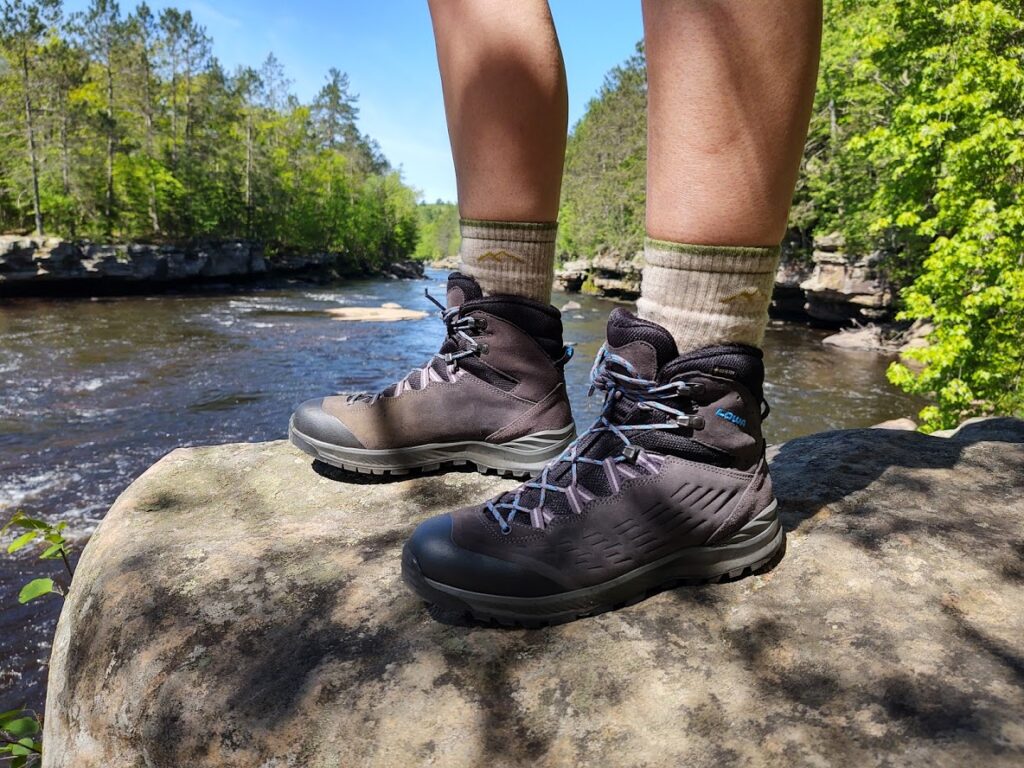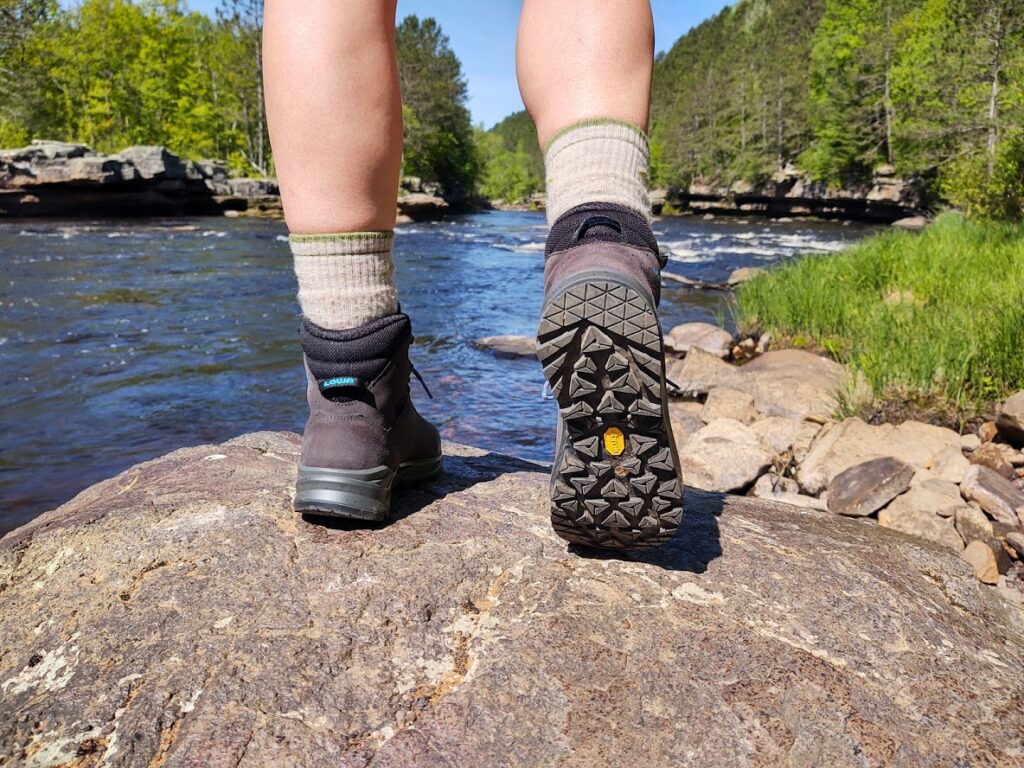The LOWA Explorer GTX Mid ($240) is a slim-downed, lightweight, fast, flexible and agile backpacking boot that blends the best of a traditional, aggressive mountainous pack-carrying mule with a modern, lightweight, agile boot. But make no mistake. The Explores are a backpacking boot.
Break-in Period
Some boots require a break-in period, some are ready to hike right outside the box. Boots that generally require a break-in period are the burly leather models in which the leather needs time to soften and conform to your feet.
My first pair of LOWA’s was the Mauria GTX back in 2014. The Mauria’s are in the class of the burly leather model hiking boot. They had been on back order and had arrived two days before I left for a hiking trip in Austria. Breaking in new boots before an epic hike is a risk but the Mauria’s ended up being that rare burly hiker that didn’t need breaking in.
And neither did the LOWA Explorer GTX mid. They were comfortably hike-able right out of box. No break-in period required.
Pro tip: I really urge you try boots on first though.
Fit
The Explorer GTX’s lacing system is a combination of webbing and metal hooks. Presumably LOWA used this combination of webbing and hooks to decrease weight. However, the metal hooks used are definitely not as brawny as the hooks on the Mauria’s, but they got the job done and delivered an outstanding fit.
Pro tip: Try your boots on at the end of the day when your feet are naturally swollen. Be sure to take your own hiking socks along.

Sizing
When it comes to hiking boots, always start with a half- or a full-size up. This is because you’ll want to accommodate thicker hiking socks and the normal foot swelling one gets from being on their feet for a few hours. The danger, though, is sizing up to big. If you go to big, your foot will swim around inside the boot causing blisters.
When I receive a pair of boots to review, the fit is a bit of a lottery because the firsts time I’m trying them on is after UPS or FedEx drop them off at my door. I wear a size 7.5 in shoes. When it comes to hiking boots or shoes, I go a half-size up. I went with the size eight in the Explorers and the fit is certainly what I’ve come to expect from LOWA.
Waterproof-ness
“GTX” is code for “Gortex”. The LOWA Explorer GTX, therefore, have a Goretex liner that make them waterproof. Hiking the Superior Hiking Trail in early June, or any of the hikes I’ve done before and after, had their share of puddles, small creek crossing, left-over snowmelt and slogs in the rain. The Goretex must work because I never had to swap wet socks for dry.
Pro tip: Allow me to clarify what waterproof means in a hiking boot. Can you walk into a knee-deep lake or river and emerge on the other side with dry feet? No. But if you’re hiking in pouring, sheeting, pelting rain or wading through puddles, or rock-hopping a shallow creek crossing and you lose your balance and you submerge your foot up to the laces, your feet should stay dry.
Support and Stability
An easy way to judge a hiking boot’s stability is to squeeze the sides of the heel counter. If it resists compression, or feels like you’re squeezing a block of cement, you have a highly-stable boot that is built to sustain long hikes on varying terrain while carrying a heavy backpack (like the Mauria GTX). If it compresses slightly you have a boot with less stability.
This is neither bad nor good. Not all hiking boots are intended to carry heavy packs for multiple days on rough trail with sharp ascents and descents. That being said, the Explorer’s split leather and fabric upper (more leather than fabric though) didn’t fully resist the compression test but it fought back gallantly. It took all the strength in my fingers just to barely move the needle.
A boot’s surface area also plays into stability. The more surface area in contact with the ground the more support the shoe offers the foot. When I compare the surface area of the LOWA Explorer GTX with that of the Mauria GTX, which is a highly-stable boot, the difference is negligible.
That sums up my experience of the Explorer GTX’s. Like the Mauria’s, they have a nice stiff, responsive platform for ascents while carrying a pack weighing around 36lbs.
Traction
No boot is immune to loose, gravelly scree or soaked rocks and wood but LOWA outfitted the Explorers with a Vibram Rock Trac with MegaGrip Rubber Compound outsole and DynaPU+ midsole to ensure optimal traction on varying trail conditions. Another contributor to traction is the lug pattern. A wider tread is better for shedding mud and debris and that ultimately is what improves your traction.
This combination certainly worked well on keeping me upright and sure-footed on the Superior Hiking Trail. It isn’t a trail with epic ascents and descents like you’d find on the Pacific Crest Trail or climbing a 14,000-foot or higher peak, but it traverses plenty a high ridgeline with rocks, roots and logs. When it rains, and these rocks, roots and logs become wet, and carrying a heavy pack, all I can say is pity the fool with a lesser boot and mediocre traction.
I rank the LOWA Explorer GTX’s, and its aggressive lugs, very high in the traction category.

Comfort and Performance
My barometer for testing a boot’s comfort may be fairly simplistic but it works:
- Do I need to stop every few miles and adjust the laces or just give my feet a rest? No.
- Do I have hotspots and/blisters? No.
- Do my somewhat-high arches feel like they’ve flattened? No.
- Do my heels throb and are sore to the touch? No.
- Is kicking them off my feet when I get to camp Priority #1? No.
The LOWA Explorer GTX mid is an insanely comfortable boot for thru-hiking, thanks to its shock-absorbing midsole slab of cushioning in the heel. Unlike the stiffer sole of its big sister the Mauria GTX, the Explorer’s sole offers an enhanced flexibility that conforms better to a natural walking gait. A nice-sized toebox allowed my toes to splay when they needed.
Pro tip: Wear a quality merino wool hiking sock and tie your laces properly.
Quality and Durability
Outstanding. They’re LOWA and they’re made in Germany (not China). Hiking is a traditional pastime in Germany, thus Germans have high standards for hiking boots. LOWA represents that national pride in the art of bootmaking. Outsourcing their product to Asia for manufacturing doesn’t allow the level of quality control they require. The result of this nit-picki’ness and quality-control freak’ness is a hiking boot with outstanding quality and durability.
I can speak to durability anecdotally. I received my first pair of LOWA’s in 2014. They’ve summitted seven fourteener’s in Colorado, hiked hundreds of miles on trails in the United States, Norway, Iceland, Scotland, Canada and the Faro Islands. Last year, I took them to Greenland. They are still rocking it with no end in sight. The leather hasn’t cracked or deteriorated. The seams are still tight and the outsoles are still attached. The only things I’ve replaced is the stock footbed (replaced with a SuperFeet footbed a few years ago) and the laces, which I replaced last year before the Greenland trip.
The downside, certainly, is that all this quality and durability come at a price. Some budget-minded hikers will find the $240 price tag of the LOWA Explorer GTX to painful. But in hiking boots, as with most things, you get what you pay for. Six years from now, when you’re still hiking in the Explorers (or just about any LOWA boot), you’ll be glad you increased your boot budget.

Final Thoughts
Because quality hiking boots aren’t cheap, I often get asked if there’s such a thing as a one-boot-that-does-it-all by folks who don’t want to invest in a heavier, stable boot for thru-hiking with a loaded pack and a lightweight shoe ideal for fast hikes in state parks with a daypack.
It’s possible that ideal one-boot-to-do-it-all is LOWA Explorer GTX Mid.
Nicely done, LOWA.

